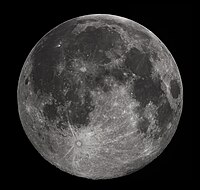
Photo from wikipedia
We have characterized the snow albedo decay over Hurd Peninsula, Livingston Island, Antarctica, for the period 2000–2016. The snow albedo was obtained from the MOD10A1 product of the spaceborne MODIS… Click to show full abstract
We have characterized the snow albedo decay over Hurd Peninsula, Livingston Island, Antarctica, for the period 2000–2016. The snow albedo was obtained from the MOD10A1 product of the spaceborne MODIS sensor. A low-pass filter is applied to the data in order to eliminate short-term variations and retain the seasonal variation of albedo. The seasonal albedo was fitted to an exponential decay function to obtain the decay rate, the duration and the starting date of the decay. On average, albedo decay starts in late September and lasts for 96 ± 20 days. Snow melting lags behind snow albedo decay. This lag is due, on the one hand, to the occurrence of dry-snow metamorphism and sublimation in the early stages of the decay, and on the other hand to persisting subsurface melting after the completion of the metamorphic processes at the surface. The albedo decay is mainly driven by the shortwave incident radiation, with air and near-surface temperatures unexpectedly playing a minor role. Near-surface-temperature controls the importance of the local topography in the albedo decay. Topography only determines the albedo decay when the snow cover is not homogeneous over the study area.
Journal Title: IEEE Journal of Selected Topics in Applied Earth Observations and Remote Sensing
Year Published: 2021
Link to full text (if available)
Share on Social Media: Sign Up to like & get
recommendations!